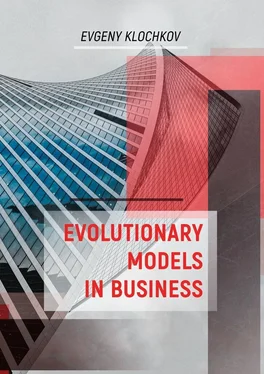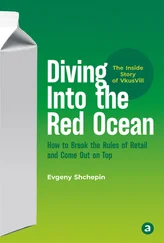Evgeny Klochkov - Evolutionary Models in Business
Здесь есть возможность читать онлайн «Evgeny Klochkov - Evolutionary Models in Business» — ознакомительный отрывок электронной книги совершенно бесплатно, а после прочтения отрывка купить полную версию. В некоторых случаях можно слушать аудио, скачать через торрент в формате fb2 и присутствует краткое содержание. ISBN: , Жанр: popular_business, на английском языке. Описание произведения, (предисловие) а так же отзывы посетителей доступны на портале библиотеки ЛибКат.
- Название:Evolutionary Models in Business
- Автор:
- Жанр:
- Год:неизвестен
- ISBN:9785005192585
- Рейтинг книги:4 / 5. Голосов: 1
-
Избранное:Добавить в избранное
- Отзывы:
-
Ваша оценка:
- 80
- 1
- 2
- 3
- 4
- 5
Evolutionary Models in Business: краткое содержание, описание и аннотация
Предлагаем к чтению аннотацию, описание, краткое содержание или предисловие (зависит от того, что написал сам автор книги «Evolutionary Models in Business»). Если вы не нашли необходимую информацию о книге — напишите в комментариях, мы постараемся отыскать её.
Evolutionary Models in Business — читать онлайн ознакомительный отрывок
Ниже представлен текст книги, разбитый по страницам. Система сохранения места последней прочитанной страницы, позволяет с удобством читать онлайн бесплатно книгу «Evolutionary Models in Business», без необходимости каждый раз заново искать на чём Вы остановились. Поставьте закладку, и сможете в любой момент перейти на страницу, на которой закончили чтение.
Интервал:
Закладка:
J. Holland in 1975. Genetic algorithms will be very useful to us for using within the framework of the paradigm proposed by the author, and their application will be discussed below.
Genetic algorithms are adaptive search-based techniques that are used to solve optimization problems. They make use of both an analogue of genetic inheritance mechanism and an analogue of natural selection, at the same time preserving biological terminology in a simplified form and basic concepts of linear algebra. The first genetic algorithm scheme was proposed by J. Holland at the University of Michigan in 1975. And Ch. Darwin’s Theory of Evolution along with the studies of L. J. Fogel, A. J. Owens, and M. J. Walsh on the evolution of simple automata intended to predict symbols in digital sequences served as the premises thereto. The new algorithm was named Holland’s reproductive plan and was later actively used as a basic algorithm in evolutionary computations. Holland’s ideas were developed by his students K. De Jong from George Mason University in Virginia and D. Goldberg from the Illinois Genetic Algorithms Laboratory. Due to them, a classical genetic algorithm was created, all operators were described and the behavior of the test functions group was investigated. It was Goldberg’s algorithm that was called the “genetic algorithm”. To understand the essence of genetic algorithms and the opportunities of their application in business, it is worth dwelling in a little more detail on the stages of this model.
Phase 1. Creation of a new population.
In the first phase, an initial population is created. Requirements for the quality of the population according to the given parameters are not critical, since in the end the algorithm will correct this problem. The most important thing is that the population should conform to the “format” and be fit for reproduction.
Phase 2. Reproduction.
It is important that the descendant (child) should be able to inherit the parents’ traits. In this case, all members of the population reproduce, and not only the survivors. Otherwise, one alpha male will stand out, whose genes will supersede all the others, and this is fundamentally unacceptable.
Phase 3. Mutations.
Mutations are similar to reproduction. A certain number of individuals are selected out of the mutants and modified in accordance with predetermined operations.
Phase 4. Selection.
At this stage, the most important process starts. The experimenter selects from the population the proportion of those who will “go further.” The proportion of those who “survived” the selection is determined in advance as a preset parameter. Then the cycle is repeated from the beginning. If the result is not satisfactory, these steps are repeated until the result becomes satisfying or until one of the following conditions is fulfilled: either the number of generations (cycles) reaches a pre-selected maximum, or the time allotted for mutation gets exhausted.
Genetic algorithms are referred to as soft computing. The term “soft computing” was introduced by L. Zadeh in 1994. This concept brings together such areas as fuzzy logic, neural networks, probabilistic reasoning, trust networks, and evolutionary algorithms, which complement each other and are used in various combinations or independently to create hybrid intelligent systems.
To put it simply, a genetic algorithm is a method of item-by-item examination within the available set for selection of only those solutions that meet the given parameters. The solution of the task to find the shortest path from point A to point B can serve as an example here. First, you need to build any possible paths from point A to point B, look for all possible options, shift existing route points, add and remove points, through which the route passes, i.e. create the maximum number of options. Then, to choose the shortest path, you need to calculate the lengths of the routes and compare them. In the process of searching, we discard some of the longest routes, compare the remaining ones, and in the end a single route, i.e. the shortest one, is left. Only practice can show which approach will be correct in the context of a specific task.
1.3. Evolutionary Processes in the World of Business
The world is in constant motion, but fluctuations occur in a very limited framework. For example, the oxygen content in the air is on average about 21%, but slight deviations are possible. However, a fall below 18% can become critical not only for humans, but for all living things on the planet. Any individual on the Earth is a genetically stable organism, that is to say it is adapted only to certain conditions of existence that have their boundaries. To preserve life on the planet, there is an ongoing process of organisms adaptation to the changing environmental conditions, requiring a higher rate of change in bioorganisms than the rate of change in environmental conditions. Life follows the path of development of living beings with predetermined, genetically determined properties, with certain qualities of survival and with a relatively short cycle of existence. The biological goal of the life of any individual is to be born, to master the living space, to bring something new to the process of mastering the living space, conducive to survival, to reproduce the offspring, to transfer this new acquisition to them, to help them get used to the living space, and to die itself. Through death, life on the planet adapts to changes in the environment. The biological meaning of the death of individuals is the entire species existence continuation.
The same is happening in the world of business. A market economy is characterized by periods of predominantly extensive and predominantly intensive types of economic growth. This alternation is primarily based upon the cyclical nature of the economic movement, namely, continuous fluctuations of the market economy, when the growth of production is replaced by a decline, and an increase in business activity is followed by a decrease. In the economic literature, cycles of varying duration have been named after their researchers. Thus, cycles lasting 3—4 years are called Kitchin cycles, 10-year cycles bear the name of Juglar cycles or Marx cycles,
15-20-year cycles are Kuznets cycles, while 40-60-year cycles are named Kondratieff cycles. Cyclicality is characterized by periodic ups and downs in market conditions. Periods of increased economic activity are characterized by predominantly extensive development, while periods of decline in economic activity are characterized by the onset of predominantly intensive development. Consequently, a cycle is a constant dynamic characteristic of the market economy. It is a form of movement and development of the market economy. Located in a pulsating environment, companies try to survive, master the living space, bring something new to the mechanisms of development – and thus adapt to the existing market.
The history of the Coca-Cola product range can be cited as a vivid example of business adaptation to the changing conditions of the surrounding world. In the 1960s, it was a ‘black sweet drink’ producing firm. In the process of development, the company restructured its assortment every 5—7 years, reducing the sugar content, altering the color, adding carbonated and degassed water, iced tea, energy drinks, and juices to its product range. As a result, today the ‘black sweet drink’ accounts for only about 15% of Coca-Cola’s assortment. Another example is SEMCO, a Brazilian industrial equipment manufacturer. The company has introduced a self-management regime. SEMCO’s 3,000 employees determine their working hours and salaries on their own. Workers hire their own supervisors and evaluate their performance. There are hammocks hanging around the plant so people can take a nap at lunchtime. If an office worker comes to work on Saturday, then on Monday they can spend the first half of the day at the beach. The company has neither a rigid organizational structure, nor five-year plans, set of corporate values, or dress code. There are no hard-copy rules or program memoranda, except for the comic-printed Survival Manual for new employees, which summarizes the unusual customs of SEMCO. Tochka Bank is an example from the Russian market. It is a multi-brand bank operating on the basis of Otkritie FC Bank and QIWI Bank, which implements holacracy, i.e. an organization management system where powers and responsibility for decision-making are distributed throughout the entire holarchy of self-organizing teams rather than being vested in a management hierarchy. Holacracy distinguishes between roles and the people who fill them. There are obligations. And there is transparency in decision-making.
Читать дальшеИнтервал:
Закладка:
Похожие книги на «Evolutionary Models in Business»
Представляем Вашему вниманию похожие книги на «Evolutionary Models in Business» списком для выбора. Мы отобрали схожую по названию и смыслу литературу в надежде предоставить читателям больше вариантов отыскать новые, интересные, ещё непрочитанные произведения.
Обсуждение, отзывы о книге «Evolutionary Models in Business» и просто собственные мнения читателей. Оставьте ваши комментарии, напишите, что Вы думаете о произведении, его смысле или главных героях. Укажите что конкретно понравилось, а что нет, и почему Вы так считаете.












